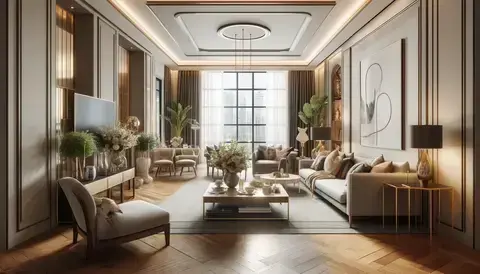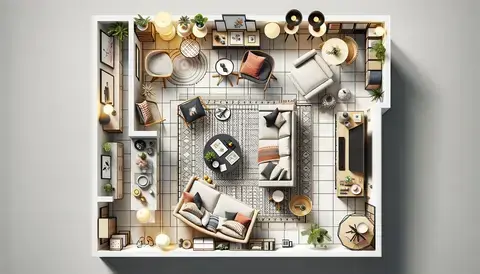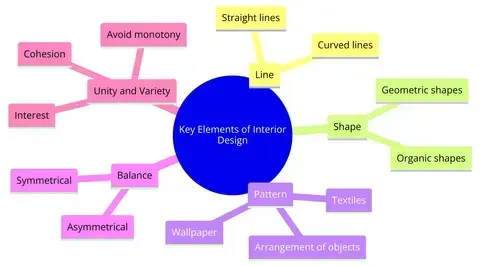Introduction to Interior Design
Introduction to Interior Design: Creating Beautiful and Functional Spaces

Free 2024 New Interior Design Course
Have you ever walked into a room and felt an immediate sense of comfort, awe, or inspiration? That's the magic of interior design at work. Interior design goes far beyond choosing pretty furniture and paint colors; it's the art and science of crafting spaces that are not only visually appealing but also functional and comfortable. In this comprehensive guide, we'll take you on a journey through the world of interior design, introducing you to its basics, principles, and the key elements that make spaces beautiful and functional.
What Is Interior Design?
At its core, interior design is the art of enhancing the interior of a space to create a more aesthetically pleasing and functional environment. It's about transforming ordinary rooms into extraordinary ones by carefully considering factors such as color, layout, lighting, furniture, and decor.
The Importance of Interior Design

Interior design plays a significant role in our lives, even if we don't always notice it. Here's why it matters:
1. Aesthetics
One of the primary functions of interior design is to make spaces visually appealing. The use of color, texture, patterns, and materials can create a particular atmosphere or style. Whether it's a cozy, rustic living room or a sleek, modern office, aesthetics set the mood and leave a lasting impression.
2. Functionality
Beautiful spaces should also be functional. Interior designers carefully plan layouts to ensure that every square foot serves a purpose. The arrangement of furniture, the flow of traffic, and the use of storage solutions all contribute to the functionality of a space.
3. Comfort
Comfort is a key consideration in interior design. It involves choosing furniture that is comfortable to sit or lie on, as well as creating spaces that promote relaxation and well-being. Factors like lighting and temperature control also play a role in comfort.
4. Personalization
Interior design allows individuals to express their personalities and preferences through their surroundings. It's a way to make a space feel uniquely yours, reflecting your tastes and interests.
Interior Design Basics

Now that we've established what interior design is and why it matters, let's delve into some of the fundamental principles and basics of this field:
1. Color Theory
Color is a powerful tool in interior design. Different colors evoke different emotions and moods. For example, warm colors like red and orange can create a sense of energy and excitement, while cool colors like blue and green promote calm and relaxation. Interior designers study color theory to create harmonious color palettes that suit the intended atmosphere of a space.
2. Space Planning
Effective space planning is crucial for maximizing the functionality of a room. It involves determining how to arrange furniture and objects in a way that makes the best use of available space while ensuring easy movement and access. Good space planning creates a sense of balance and harmony in a room.
3. Furniture and Layout
Selecting the right furniture and arranging it properly is essential in interior design. Furniture should not only look good but also be comfortable and suited to the room's purpose. The layout should consider factors like traffic flow, focal points, and the natural flow of daily activities.
4. Lighting
Lighting can completely transform a space. Interior designers understand the importance of natural and artificial lighting. They consider the placement of windows, the use of lamps, and the type of lighting fixtures to create the desired ambiance and mood.
5. Materials and Textures
Materials and textures add depth and richness to a space. Interior designers choose materials like wood, metal, glass, and fabrics to create a tactile experience. The juxtaposition of different textures can make a room feel more inviting and dynamic.
Key Elements of Interior Design

To create beautiful and functional spaces, interior designers work with a set of key elements:
1. Line
Lines in interior design can be straight, curved, or a combination of both. They guide the eye and create visual interest. For instance, curved lines can add softness and flow to a room, while straight lines convey a sense of order and stability.
2. Shape
Shapes are fundamental in design. Geometric shapes like squares and rectangles can create a sense of structure, while organic shapes like circles and curves can add a more relaxed and natural feel.
3. Pattern
Patterns can be incorporated through textiles, wallpaper, or even in the arrangement of objects. They add personality and can be used to emphasize certain design elements.
4. Balance
Balance in interior design ensures that a space feels visually stable and harmonious. There are two types of balance: symmetrical (where elements are evenly distributed) and asymmetrical (where elements are arranged in a more informal, but still balanced, manner).
5. Unity and Variety
Unity in design creates a sense of cohesion, making all the elements in a room feel like they belong together. Variety, on the other hand, adds interest and prevents monotony. Striking the right balance between unity and variety is a hallmark of effective interior design.
In this introduction to interior design, we've explored the basics, principles, and key elements that make this field both an art and a science. Interior design goes beyond mere aesthetics; it's about enhancing the functionality, comfort, and beauty of the spaces we inhabit.
Whether you're considering a career in interior design or simply want to improve your living spaces, understanding the fundamentals can be a valuable asset. As you continue your journey into the world of interior design, remember that creating beautiful and functional spaces is a creative and rewarding endeavor that allows you to shape the environments in which we live, work, and play.
FAQs
1. What is the basic introduction of interior design?
- Answer: Interior design is a multifaceted field that involves enhancing the interior spaces of buildings for improved functionality, aesthetics, and overall well-being. It encompasses the arrangement of furniture, color schemes, lighting, and decor to create harmonious, efficient, and aesthetically pleasing environments. Interior designers consider both the practical and artistic aspects of a space, working to meet the needs and preferences of the occupants.
2. What are the 7 concepts of interior design?
- Answer: The seven key concepts of interior design include:
- Space: How space is utilized, divided, and connected.
- Line: The use of lines to guide the eye and define shapes.
- Form: The three-dimensional shape and structure of objects.
- Light: The manipulation of natural and artificial light for ambiance.
- Color: The selection and combination of colors for visual impact.
- Texture: The tactile quality of surfaces within a space.
- Pattern: The repetition of design elements for visual interest.
3. What is the concept of interior design?
- Answer: The concept of interior design revolves around creating environments that are not only aesthetically pleasing but also functional and conducive to the well-being of the occupants. It involves the thoughtful arrangement of elements such as furniture, color, lighting, and accessories to transform interior spaces into cohesive, purposeful, and visually appealing settings.
4. How do you explain interior design?
- Answer: Interior design is the art and science of enhancing the interior of a building to create a more aesthetically pleasing and functional environment. It involves a holistic approach to design, considering factors such as spatial planning, color schemes, furniture selection, lighting, and decor. Interior designers work to optimize the use of space, enhance the overall atmosphere, and cater to the specific needs and preferences of the people using the space.
Keep Learning
Learn more about Interior Design
Expand your knowledge and skills in interior design with these related topics and subjects. These recommendations include popular books and courses from various learning platforms to help you delve deeper into the world of interior design.
Related Topics
1. Advanced Interior Design Techniques
Explore sophisticated design strategies that can transform any space.
2. Sustainable Interior Design
Learn how to incorporate eco-friendly materials and practices into your designs.
3. Interior Design Styles and Trends
Discover the latest trends and timeless styles in interior design to keep your projects fresh and relevant.
4. Color Psychology in Interior Design
Understand how different colors can affect mood and behavior, and learn to apply this knowledge in your designs.
5. Space Planning and Layout
Master the art of optimizing space to enhance both functionality and aesthetics.
Recommended Readings
Books
"The Interior Design Reference & Specification Book" by Chris Grimley and Mimi Love
- A comprehensive guide to essential interior design principles.
- Buy on Amazon
"Homebody: A Guide to Creating Spaces You Never Want to Leave" by Joanna Gaines
- Learn from a seasoned designer about creating warm, inviting spaces.
- Buy on Amazon
"Elements of Style: Designing a Home & a Life" by Erin Gates
- A blend of personal stories and practical design advice.
- Buy on Amazon
- A collection of essays from top designers offering insights into their craft.
- Buy on Amazon
"Design*Sponge at Home" by Grace Bonney
- A guide to creating beautiful and personalized home spaces.
- Buy on Amazon
Recommended Courses
LinkedIn Learning
- Interior Design Foundations
- Learn the basics of interior design and space planning.
- Learn more on LinkedIn Learning
MasterClass
- Kelly Wearstler Teaches Interior Design
- Learn design principles from renowned interior designer Kelly Wearstler.
- Enroll on MasterClass
edX
- The Science of Well-Being by Yale University
- Understand the principles of well-being and how they can be applied to design.
- Enroll on edX
Study.com
- Interior Design Basics Course
- A foundational course covering the essentials of interior design.
- Learn more on Study.com
Coursera
The Language of Design: Form and Meaning
- Offered by the California Institute of the Arts, this course explores the relationship between design elements.
- Enroll on Coursera
Designing the Interior: Furniture and Decor
- Learn how to choose and arrange furniture and decor to enhance any space.
- Enroll on Coursera
Udemy
Interior Design Masterclass
- An in-depth course that covers everything from color theory to advanced design techniques.
- Enroll on Udemy
Sustainable Interior Design
- Focus on eco-friendly design practices to create sustainable living spaces.
- Enroll on Udemy
Skillshare
- Interior Design Essentials: Creating A Color Palette
- Learn the basics of creating a cohesive color palette for your designs.
- Learn more on Skillshare
By exploring these resources, you can deepen your understanding of interior design and refine your skills to create spaces that are not only beautiful but also functional and sustainable.
